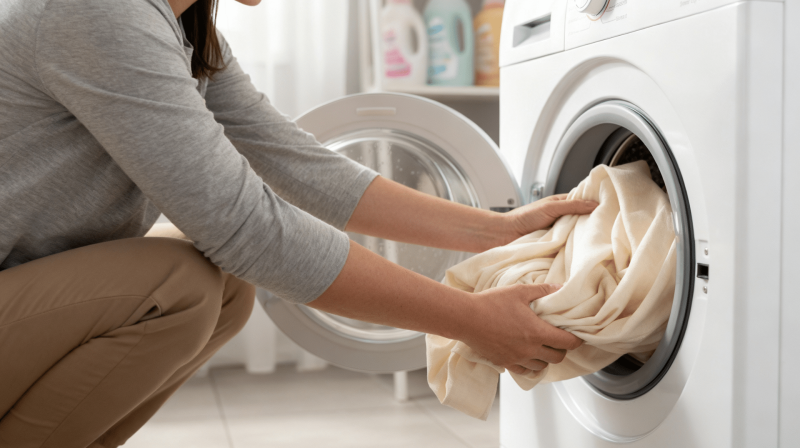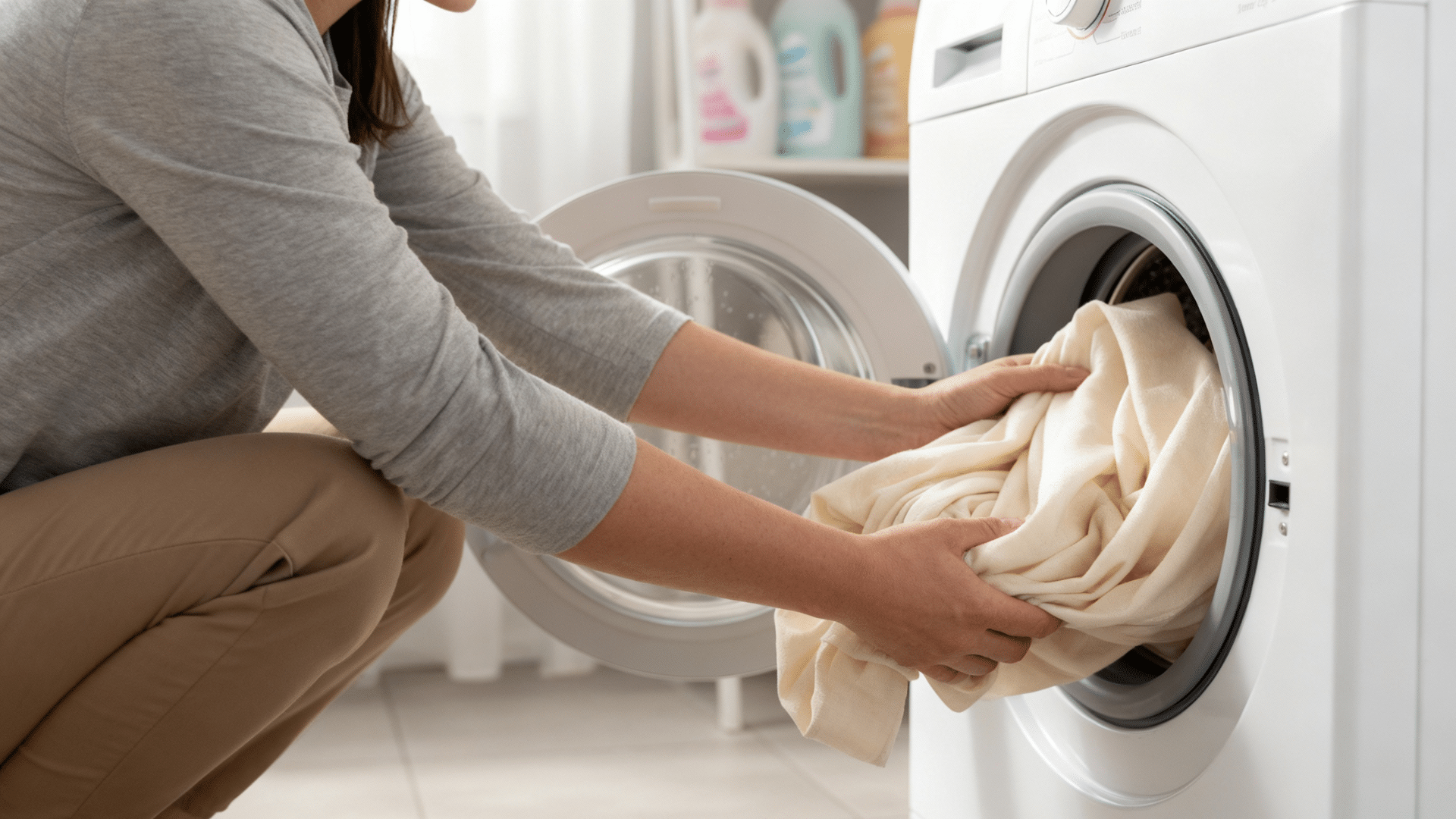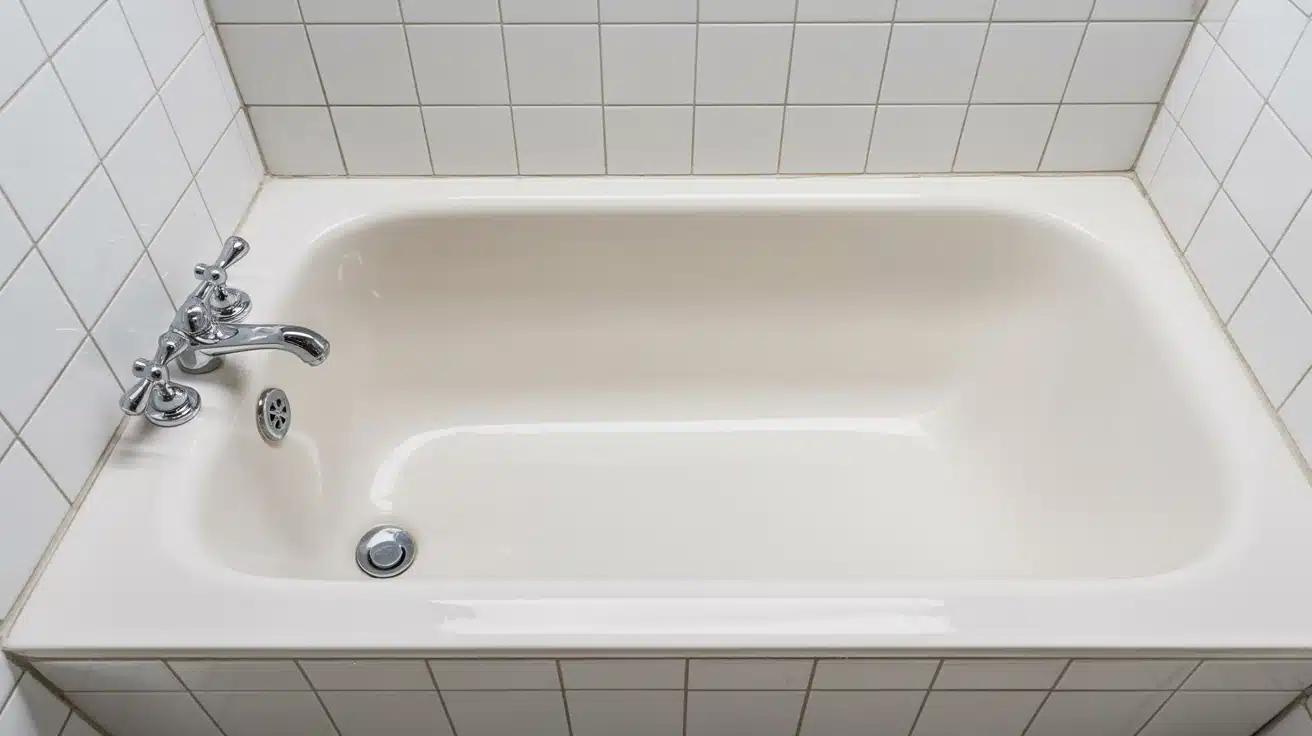Dirty curtains collect dust, allergens, and odors over time.
Most people struggle to clean them properly without damaging the fabric. This blog promises simple solutions for all curtain types.
You will learn hand-washing techniques, machine-washing tips, and dry-cleaning alternatives.
The blog covers how to clean curtains with common mistakes to avoid. By the end, anyone can refresh their curtains and keep them looking fresh for years.
How Often Should You Clean Your Curtains?
Most curtains need cleaning every 3 to 6 months. Homes with pets or smokers require more frequent washing, about every 2 months.
Kitchens collect grease and food odors faster, so the curtains there need monthly attention. Light-colored fabrics show dirt quickly and benefit from regular care.
Curtains of different sizes, like the heavy drapes in low-traffic rooms can wait up to a year between cleanings.
Regular vacuuming between washes helps remove surface dust. Simple maintenance extends the curtain life and keeps rooms fresh.
How to Clean Cotton Curtains?

Cotton is durable and handles washing well. Most cotton curtains survive machine washing without problems.
However, checking the care label first prevents unwanted shrinkage.
1. Remove Dust and Debris
Take the curtains down and shake them outside. This removes loose dirt, pet hair, and dust particles.
Vacuum both sides using an upholstery attachment. Pay extra attention to pleats and folds where dust collects.
2. Pre-Treat Stains
Apply mild detergent directly to visible stains. Gently rub the fabric together to work in the solution.
Let it sit for 10 minutes before washing. This breaks down oils and stubborn marks effectively.
3. Machine Wash on Gentle Cycle
Place curtains in the washing machine with cold water. Add mild detergent and select a gentle or delicate cycle.
Avoid bleach as it weakens cotton fibers over time. Wash similar colors together to prevent dye transfer. Avoid hot water as it causes cotton to shrink too.
4. Air Dry or Low Heat
Hang curtains while slightly damp to prevent wrinkles. If using a dryer, choose the lowest heat setting available.
Remove them promptly when the cycle finishes. High heat damages fabric and causes permanent creasing.
Steps to Wash Sheer Curtains

Sheer fabrics are delicate and tear easily. They require gentle handling throughout the cleaning process.
Hand-washing gives the best results for these lightweight materials.
1. Fill the Basin with Cool Water
Use a clean bathtub or a large sink for washing. Fill it with cool water, never hot or warm.
Add a small amount of gentle detergent designed for delicates. Mix the solution until it creates light suds throughout.
2. Soak Gently
Submerge the curtains completely in the soapy water. Let them soak for 15 to 20 minutes without agitation.
This loosens dirt without stressing the delicate fibers. Avoid twisting or wringing the fabric at any point.
3. Rinse Thoroughly
Drain the soapy water and refill with clean, cool water. Gently swish curtains to remove all detergent residue.
Repeat rinsing until water runs clear and no suds remain. Leftover soap makes fabric stiff and attracts more dirt.
4. Press Out Excess Water
Lay curtains flat on a clean towel. Roll the towel with curtains inside to absorb moisture.
Never wring or twist sheer fabric as it damages threads. Hang them immediately to finish drying in the open air.
Washing Synthetic Curtains

Synthetic materials like polyester resist wrinkles well. They dry faster than natural fibers and hold colors better. Machine-washing works perfectly for most synthetic curtain types.
1. Check Care Label First
Read the manufacturer’s instructions before starting any cleaning process. Some synthetics have a special coating that needs specific care.
Note the recommended water temperature and drying method. Following the guidelines protects the fabric’s special properties.
Note: Ignoring care labels voids warranties on expensive curtains.
2. Use Warm Water Wash
Set the machine to a warm water, gentle cycle. Add regular laundry detergent in the recommended amount.
Avoid fabric softeners as they leave residue on synthetics. The warm temperature removes oils without damaging polyester fibers.
3. Add White Vinegar
Pour half a cup of white vinegar during the rinse cycle. This removes any detergent buildup and static electricity.
Vinegar also refreshes colors and eliminates lingering odors naturally. The smell disappears completely once the curtains dry.
4. Tumble Dry Low
Use the lowest dryer setting to prevent heat damage. Remove curtains while slightly damp to avoid over-drying.
Hang them immediately to let the remaining moisture evaporate. Synthetic fabrics rarely need ironing after proper drying.
Steps to Blockout Curtains

Blockout curtains have a special backing that blocks light. This coating requires careful cleaning to maintain effectiveness. Always test a small corner first before washing completely.
1. Vacuum Both Sides Regularly
Use a soft brush attachment to clean the front and back. This removes dust without wetting the special backing layer.
Focus on seams where dirt accumulates over time. Regular vacuuming reduces how often deep cleaning is needed.
2. Spot Clean Stains Only
Mix mild soap with cool water for targeted cleaning. Dab the stain gently with a soft cloth; don’t rub.
Work from the outside of the stain toward the center. Rinse with a clean, damp cloth and pat dry immediately.
Avoid soaking blockout curtains as it damages the light-blocking coating permanently.
3. Hang Dry Immediately
Support the full weight while hanging to prevent stretching. Choose a shaded area away from direct sunlight.
Let air circulate freely around all sides for even drying. Never use heat or put blockout curtains in a dryer
How to Clean Silk Curtains?

Silk is the most delicate curtain fabric available. It stains easily and loses color when cleaned improperly. Professional dry cleaning is the safest option for valuable silk.
1. Dust with Soft Brush
Use a clean, soft-bristled brush to remove surface dust. Brush gently in downward strokes following the fabric grain.
This prevents dirt from embedding deeper into silk fibers. Regular dusting reduces the need for wet cleaning methods.
Do not vacuum silk curtains it causes snags and permanent damage.
2. Test for Colorfastness
Dampen a white cloth with cool water. Press it against an inconspicuous area of the curtain.
Check if any color transfers to the white cloth. If color bleeds, only professional dry cleaning is safe.
3. Hand Wash with Extreme Care
Fill a basin with cold water and silk-specific detergent. Submerge curtains and gently agitate for two minutes maximum.
Never soak silk for longer as it weakens the fibers. Rinse quickly in cold water until all soap is gone.
4. Dry Flat Away from Sunlight
Lay silk curtains flat on clean, white towels. Roll towels to absorb excess moisture without wringing fabric.
Reshape curtains to original dimensions while damp. Hang in a dark room, as sunlight causes fading.
Important Do’s and Don’ts
Following basic guidelines makes curtain cleaning safer and more effective. Simple do’s and don’ts prevent common mistakes that damage fabric.
| Do’s | Don’ts |
|---|---|
| Always read and follow the care label instructions before cleaning any curtain type. | Don’t use hot water on delicate fabrics like silk, sheer, or synthetic materials. |
| Vacuum curtains regularly between washes to prevent dust buildup and extend cleaning intervals. | Don’t overload the washing machine, as curtains need space to move and clean properly. |
| Test cleaning solutions on a hidden area first to check for color bleeding or damage. | Don’t wring or twist wet curtains, especially delicate fabrics that tear or distort easily. |
| Remove curtains promptly from the dryer to prevent wrinkles from setting into the fabric. | Don’t skip the rinse cycle, as soap residue attracts dirt and stiffens curtain material. |
| Rehang curtains immediately after drying so gravity helps smooth out remaining wrinkles naturally. | Don’t ignore small stains, as they set permanently and become much harder to remove later. |
To Wrap Up
Clean curtains make rooms look fresh and improve indoor air quality significantly.
Each fabric type needs its own approach, from machine-washing cotton to hand-washing delicate silk.
Remember to check care labels before starting any cleaning process. Vacuum curtains monthly between deep cleans to maintain their appearance and freshness.
Fresh, clean curtains transform living spaces and create healthier home environments.
Start with one room today and notice the difference immediately. Clean curtains are worth the effort invested.







